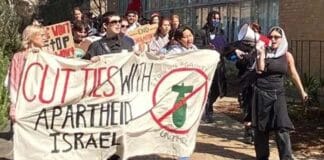On the last day of work for 2015, the University of Sydney’s Chancellor, Belinda Hutchinson, announced a drastic restructure of the University.
The decisions were made in a secret Senate meeting days earlier. They include amalgamating ten faculties and six schools into six faculties and three schools and cutting down 122 degrees to 20 degrees.
While they’re at it, they’re removing five alumni and two staff-elected from the University Senate.
Education and Social Work and Sydney College of the Arts students are extremely displeased about the plan to merge them both with the Faculty of Arts and Social Sciences.
EdSoc, the Education and Social Work Student Society, created a survey with the option to show support or opposition to the merger. After it was shared just once through Facebook last year, 250 students registered opposition. Not a single student registered support.
One student wrote, “This would be a travesty for all faculties involved and would severely damage not only the quality of teaching but the student experience.” Another, “I’m very worried this merger is more about cutting costs then increasing the quality of social work education.”
The Faculty of Agriculture and Environment and the Faculty of Veterinary Science are set to move under Science, and share the new school of Life Sciences and the Environment with Biology.
Many details are still yet to be finalised, but the Chancellor’s email confirmed the intention to merge Medicine, Pharmacy, Nursing and Dentistry in a new Medical Science faculty. Already, the University’s website has been updated to fit the restructure. You can now find Veterinary Science through the Science faculty website. The University doesn’t want new students to get a taste of the old structure.
As well as EdSoc’s organising, the College of the Arts students called an open meeting for students to voice their concerns. Both groups have thrown their support behind a campus rally against the restructure for 16 March.
Management myths
Management claims students will be better off under the changes. But with less teaching and general staff, this is about placing profit before students and cutting back staff. Administration is already being centralised in preparation. One academic working in the faculty of Education and Social Work describes their faculty’s administration staff as being the holders of “institutional memory” who are essential for specialised support.
Generalising curriculum will no doubt lead to academic staff losing their jobs, too. Management explicitly aims stop “overlap” and “duplication”. But they are out of touch with the curriculum. One Biology lecturer pointed out that “Botany taught by Biology is completely different to botany taught from an agricultural perspective”, but they are set to be amalgamated.
The Sydney College of the Arts faces the shutdown of their whole campus at Callan Park, and a transfer to the main campus without essential studio and gallery space. The move also puts subject areas that require specialised studios and expensive materials, like Glass Blowing and Ceramics, under threat.
Management claims SCA and other faculties are financially unsustainable. But the University has significant savings and makes the choice to deprioritise learning quality. Last year the University spent millions on a new Business School.
The restructure is a product of the shift towards a user-pays, market-driven education system which has seen adapt into corporate, money-making machines. Universities, in an intense competition over students, look to channel prestige, believing wooing to investors and keeping a well-maintained Jacaranda provide the edge they need to enrol a high number of students. Then they abandon these students in oversized classes with fewer staff.
We can fight and win
At Sydney University students have fought against faculty amalgamations and staff cuts in the past, and won.
The successful campaign to stop the merger between the Political Economy Department and the Department of Politics and International Relations in 2011 demonstrates that grassroots student organising is key. In that campaign, a major student meeting followed by rallies and motions in lecture theatres brought management to heel.
Management refuses to hold real consultations, so we need to make democratic spaces for students to voice their opposition. Faculty meetings can bring together students and build for rallies and direct action in large numbers.
Disrupting business-as-usual can capture attention and embarrass the university. Hitting the campus in the early weeks of semester is key.
All students can get involved, organise a contingent from their class to the 16 March rally, and talk to classmates and teachers.
By Dylan Griffiths
Sydney Uni SRC Education Officer





